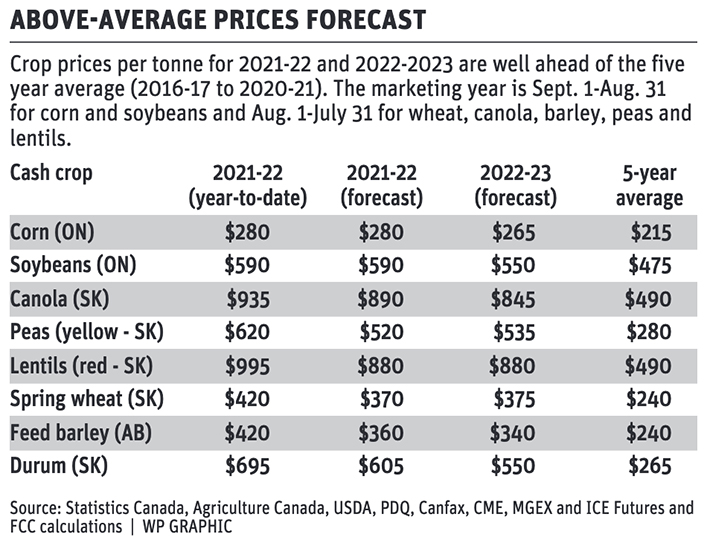Farm Credit Canada believes strong global, domestic demand will prompt farmers to seed five percent more of the crop
Economists at Canada’s largest farm lender project a 4.8 percent increase in western Canadian canola acres in 2022 and a 3.1 percent increase in Canadian soybeans plantings.
In its 2022 ag economic outlook held late last month, Farm Credit Canada said a continuation of strong global and domestic demand for oilseeds will likely translate into larger prairie canola plantings this spring.
“In Western Canada, we’re forecasting to see canola acres increase, we’re thinking pretty close to five percent overall,” said Craig Klemmer, principal agricultural economist at FCC.
Field pea plantings were projected to increase three percent over 2021, while wheat and durum acres are expected to see modest increases, in the range of 1.3 percent.
Plantings of corn and lentils were projected to decrease by 4.4 percent and 2.9 percent respectively, although FCC cautioned that several factors would influence planting decisions over the next few months, including commodity markets, drought forecast, the pace of the spring melt in Western Canada and the price and availability of crop inputs, most notably fertilizer and chemicals.
“Overall, the drought situation is something that we’re going to have to monitor,” said Klemmer, adding that a large portion of Western Canada was still facing “extreme” drought conditions as of Dec. 31.
Input costs will also be a key factor.
During the first three quarters of 2021, farm input prices rose on average by 12 percent, FCC said.
Fertilizer prices have risen sharply and are expected to remain well above the five–year average for the remainder of the 2021-22 crop year and well into 2022-23, FCC said.
The average price of urea in 2021-22 was projected at $1,130 per tonne, up from $550 in 2020-21, according to data presented by FCC.
Average anhydrous ammonia prices were projected at $1,525 per tonne this year versus $875 last year, and year-over-year ammonium phosphate prices were projected $600 higher on average in 2021-22, at $1,380 per tonne.
FCC highlighted inflationary pressures on farm inputs, geopolitical tensions and potential disruptions to international trade as major issues that should be monitored.
“If we take a look at the availability and cost of inputs, they’re going to be a major concern for producers for this year,” Klemmer said.
On a year-over-year basis, average herbicide prices were up an estimated 80 percent, with even sharper increases in specific herbicide products such as glyphosate.
In addition to rising input prices, the cost of capital will also be increasing, although it remains to be seen how quickly commercial lending rates will rise.
On Jan. 26, the Bank of Canada left its overnight lending rate unchanged at 0.25 percent but warned of future rate increases that will be needed to keep Canadian inflation in check.
Canada’s overall inflation rate in 2021, based on increases to the consumer price index, was calculated at 4.8 percent — a number that many observers believe underestimates the overall inflationary pressure being felt by farmers and ordinary Canadians.
FCC chief economist J.P Gervais said Canada’s inflation rate has surprised many economists and is likely to remain above the Bank of Canada’s target inflation rate of two percent for some time.

“It’s fair to say that most economists … underestimated the persistence of inflation,” he said.
Inflationary pressure, caused by supply chain disruptions, labour shortages and monetary policy, is expected to subside in the second half of 2022, he added.
To dampen inflation, Bank of Canada rates are expected to increase beginning in March, he added.
“If you look at 2022, the expectation of financial markets is that the Bank of Canada overnight rate is going to be up by 125 basis points between now and the end of 2022 … so that’s 1.25 percent,” he said.
In the meantime, grain and oilseed producers should continue to see strong demand for their products, FCC economists said.
Inflation aside, total Canadian farm cash receipts are projected to increase by another 4.6 percent in 2022, following a 10 percent year-over-year increase in 2021.
A summary of the FCC’s 2022 economic outlook can be viewed here.
















